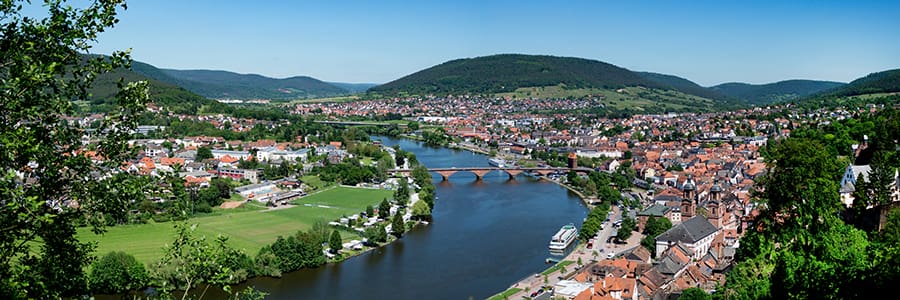
About The Main River
The name is pronounced like “mine” in English.
At 326 miles long, Germany’s Main river is the longest right tributary of the Rhine. Beginning near Kulmback in Franconia at the joining of its two headstreams, the Red Main and the White Main, its mainspring flows through the German states of Bavaria, Baden-Burttemberg, and Hesse.
Running through cities such as Frankfurt, Offenbach, Wertheim, and Wurzburg, the river offers stunning scenery as well as a wealth of historical and cultural attractions. From modern Mainz to Bavarian towns where wine and traditional crafts continue to be manufactured as they have been for centuries, the river is lined with lovely forests, small towns, spectacular palaces, and the romantic ruins of hilltop castles and churches.
River cruisers are the ideal way to explore this charming corner of Germany. Spending more time in the cities, towns, and ports along the way, you’ll enjoy plenty of guided tours highlighting the culture, art, and history of each destination, along with ample opportunities to soak up the atmosphere at your own pace. Almost always combined with the Danube or Rhine Rivers, or sometimes both, The Main carries you to the quintessential Germany.
Main River Stats
Length: 326 miles
Depth: Average of 8 feet
Source: Upper Franconia, Germany
Mouth: Rhine River near Mainz, Germany
Locks: 34
Countries: Germany
Learn More About The Main River of Europe
The Main River, often referred to as the “Main” in German, is one of the most significant waterways in Germany. Stretching for approximately 527 kilometers (327 miles), it flows through some of the most picturesque regions of the country, serving as a vital transportation route, a natural beauty, and a cultural symbol. In this exploration, we will delve into the Main River’s history, geography, economic importance, and its role in the lives of the German people.
Geography and Route
The Main River originates from the confluence of the White Main and the Red Main near Kulmbach in Upper Franconia, Bavaria. From this point, it embarks on its journey, flowing westward through central Germany before joining the Rhine River at Mainz. Along its course, it passes through several major cities and regions, including Bayreuth, Bamberg, Würzburg, and Frankfurt. One of the most remarkable features of the Main River is its connection to the Rhine-Main-Danube Canal, which links the North Sea to the Black Sea. This connection makes the Main River an integral part of Europe’s extensive inland waterway system, facilitating trade and transportation across the continent.
Historical Significance
The Main River has played a vital role in the historical development of the regions it traverses. Settlements along its banks date back to ancient times, with the Celts, Romans, and later the Franks establishing communities in its vicinity. The river served as a trade route during the Middle Ages, allowing goods to be transported between the North Sea and the Mediterranean. This economic significance led to the growth of cities such as Frankfurt and Würzburg, which flourished as trading hubs. Throughout history, the Main River has been a witness to political changes and conflicts in Germany. It marked the boundary between various territories and kingdoms, leading to the construction of fortifications and castles along its course. Today, many of these historical landmarks still stand as a testament to the river’s enduring cultural significance.
Economic Importance
The Main River continues to be a crucial economic artery for Germany. It facilitates the transportation of goods, including raw materials, industrial products, and agricultural produce. The river’s accessibility to larger vessels due to modernization efforts has further boosted its role in the transport sector. Ports and harbors along the Main River are vital for the efficient distribution of goods both domestically and internationally. Additionally, the river’s picturesque surroundings have made it a popular destination for tourism. The Main River Valley, known as the “Mainfranken,” is famous for its vineyards, charming towns, and historic castles. Tourists from around the world are drawn to the region, contributing significantly to the local economies.
Cultural and Recreational Significance
Beyond its economic contributions, the Main River holds immense cultural and recreational value for Germans. Its banks are lined with cycling and hiking trails, providing opportunities for outdoor enthusiasts to explore the scenic landscapes. The river also hosts numerous festivals and events, celebrating its cultural heritage and natural beauty. One of the most iconic festivals along the Main River is the “Bamberg Sandkerwa,” a lively celebration in the picturesque town of Bamberg. This festival attracts visitors from all over the world with its vibrant atmosphere, music, and local cuisine.
Environmental Considerations
In recent years, there has been a growing emphasis on environmental conservation along the Main River. Efforts have been made to protect the river’s water quality and ecosystems. Measures to mitigate pollution and enhance biodiversity have been implemented to ensure that the Main River remains a sustainable resource for future generations.
